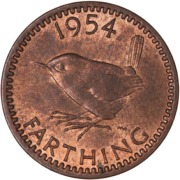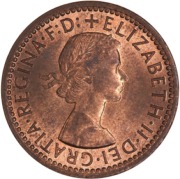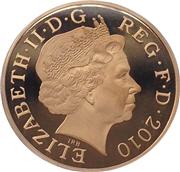 The 1954 Farthing - Elizabeth II
The 1954 Farthing - Elizabeth IIElizabeth II Bronze Farthing (1/4 penny). Diameter 20mm and weighs 2.77g. SCBC 4159. Common and inexpensive.
The Reverse shows a Wren (a small British bird) by H. Wilson Parker, who has his mongram of HWP below right. Legend is FARTHING with date above.
The edge is plain.
 The Obverse, by Mary Gillick, shows the young laurel head of Queen Elizabeth II facing right. Legend is ELIZABETH II DEI GRATIA REGINA F D.
The Obverse, by Mary Gillick, shows the young laurel head of Queen Elizabeth II facing right. Legend is ELIZABETH II DEI GRATIA REGINA F D.Images used by permission of Museums Victoria
Mintage: 6,566,000 (may include coins in sets)
Minted at The Royal Mint
More information (monarch, year, mint, country, category) can be found below coin listings.
Below are some coins currently being offered on eBay. As an eBay Partner, We may be compensated if you make a purchase.
List items on:
List items on:
Remember 1954 ?
Monarch is Queen Elizabeth II. Prime Minister is Winston Churchill (Conservative) who becomes the first Prime Minister to reach his 80th birthday while still in office. The US President is Dwight D. Eisenhower (R-Kansas/New York) who has Richard Nixon as vice-president. Roger Bannister is first to run a 4-minute mile. Marilyn Monroe marries baseball player Joe DiMaggio. The first Burger King opens in Miami. J. R. R. Tolkien publishes 'The Lord of the Rings'. Elvis Presley releases his first single 'That's All Right'.
Elizabeth II (1952-2022)
 Queen Elizabeth II was the longest reigning British Monarch ever, reigning for over 70 years. Born on 21 April 1926 to King George VI and Elizabeth Bowes-Lyon, she became Queen in 1952 and her Coronation was on 2 June 1953. She died on 8 September 2022. Some coins were released dated 2023.
Queen Elizabeth II was the longest reigning British Monarch ever, reigning for over 70 years. Born on 21 April 1926 to King George VI and Elizabeth Bowes-Lyon, she became Queen in 1952 and her Coronation was on 2 June 1953. She died on 8 September 2022. Some coins were released dated 2023.Queen Elizabeth II issued many coins and was monarch during decimalisation. She married Prince Philip, Duke of Edinburgh in 1947 and had four children. Her eldest son succeeded the throne as King Charles III. House of Windsor.
Category: Farthings
The Farthing was a small British coin that was worth one-quarter of an old penny - 1/960th of a Pound. It's name derives from the Anglo-Saxon feorthing or fourthling, meaning fourth part. It was last minted in 1956. Origins of the English Farthing
Farthings were minted as early as the 13th century under the reign of Edward I, although they may have been minted earlier under Henry III. Early examples are rare. These were small silver coins but they competed with 'cut-coinage' where a penny would be literally cut into four and used as a quarter of a penny. Farthing were minted in silver, copper and tin.
British Farthings
After the Act of the Union in 1707 (which unified England and Scotland), copper farthings were minted on a more regular basis. In 1799 Matthew Boulton started producing farthings in his steam-powered Birmingham factory (famous for making the cartwheel penny and twopence). The reverse was marked '1 FARTHING' which was the first time a denomination had ever appeared on a British or English coin. It was also the first coin to have the date on the same side as the Monarch. Boulton made another batch in 1806 and the Royal Mint took over in 1821. Farthing were made under George IV and William IV and the design was generally that of a small version of a penny, with Britannia on the reverse.
Farthings were minted in most of the years of Victoria's reign. The same obverse dies were used for the copper farthing and the sovereign and probably were used for the gold coin first. Victoria was the only monarch to have two obverses: a 'Bun' head and the Old or 'Veiled' head.
1860: Bronze replaces Copper
By 1860, the government decided to switch from copper to alloys so as to improve the quality of the coinage. Pennies, halfpennies and farthings were struck in bronze, both in Birmingham and at the Royal Mint. Bronze is 95% copper, 4% tin and 1% zinc and this was used with only minor changes until the end of the farthing in 1956.
 Farthings continued to be minted almost every year and the design was the same as the penny (with Britannia on the reverse). There was a pattern design for the Edward VIII farthing in 1936 but none were actually made in production.
Farthings continued to be minted almost every year and the design was the same as the penny (with Britannia on the reverse). There was a pattern design for the Edward VIII farthing in 1936 but none were actually made in production. The Wren and Demonetisation
In 1937 the farthing at long last got it's own unique reverse: a wren, designed by artist Harold Wilson Parker. By the 1950's inflation had eroded the spending power of the farthing (which was just 1/960th of a Pound) and with it the support of the public waned too. Production was discontinued after 1956 and the coin ceased to be legal tender after 31st December 1960.
Which Mint: The Royal Mint
The Royal Mint is the designated place for the UK to mint coins. It dates back well over 1000 years and is a Government-owned company. Formed in the reign of Alfred the Great about the year 886, during the period 1279-1812 it was generally referred to as The Tower Mint as it was housed at the Tower of London. The Master of The Royal Mint has included famous figures such as Sir Isaac Newton.
Since 2010 it has operated as Royal Mint Ltd, a company owned by HM Treasury, under an exclusive contract to supply all coinage for the UK although it also produces medals and coins for other countries. It is currently located at Llantrisant, Wales.
Country of Origin: United Kingdom
The United Kingdom (UK) is the Union of England, Scotland, Wales and Northern Ireland. It is often refered to as Great Britain (GBR). It has a long, rich history. The orignal coinage was Pounds, Shillings and Pence but since decimalisation on 15 February 1971, it is £1 = 100p, that is One Pound = 100 pence. The coinage of the UK is also a long history, the Royal Mint being established as long ago as 886AD when coins were hammered. Today there is perhaps 30 billion coins in circulation, and many (numismatic) collectors coins and sets are issued frequently in gold, silver and other metals.








